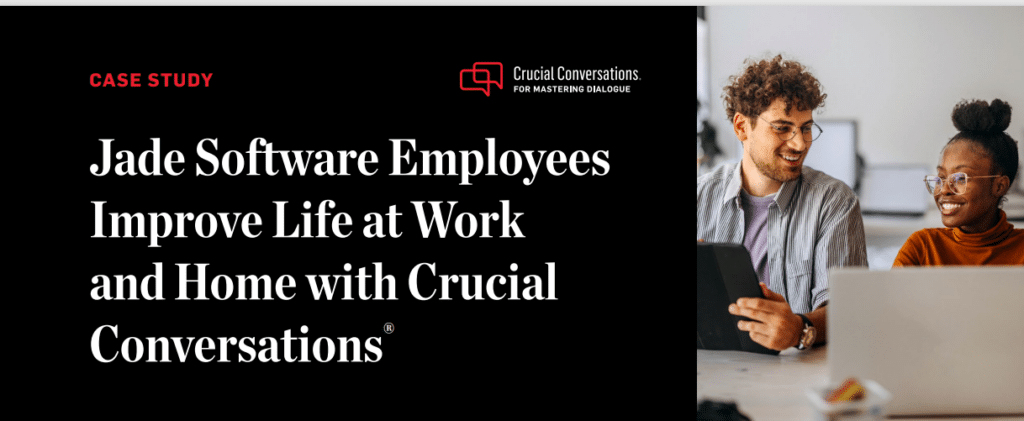As leaders, we have a natural tendency to rely on verbal persuasion to influence others. We expect to see big results from using lectures, sermons, data dumps, and rants.
This is a huge mistake!
We use verbal persuasion because it’s convenient, not because it’s effective.
If we want to be effective, we need to use something that touches the person’s heart with direct experience or vicarious experience — like a well-told story.
Let me give you an example.
We were working with a hospital and we wanted nurses to remind physicians to wash their hands to prevent hospital-acquired infections. So, we set up a simulation where we had nurses working in a room and a physician (an actor) comes in and hasn’t washed their hands.
We found out that only 10% of the nurses spoke up to remind the physician to wash their hands.
Unfortunately, 10% wasn’t what we were hoping for, but we found a subgroup of nurses that were 50% likely to speak up.
Here’s what made these nurses unique: either the nurse, a family member, or close friend had contracted a hospital-acquired infection. For these nurses, it was personal! It was a moral issue because of their personal experiences, and it showed us how powerful stories can be at effecting behaviour change.
Six Sources in Ghana’s Mines
We recently talked about our experience with Newmont Mining.
Newmont Mining has gold and copper mines all around the world, and they called on us to help them with workplace safety. There were serious injuries and deaths occurring in traffic-related accidents that needed to be reduced.
First, we identified speeding as the vital behaviour that needed to change in their drivers. Then, we used the Six Source model to diagnose why their drivers were speeding.
Once we identified the vital behaviour and diagnosed the sources of influence, we needed to take action using more than verbal persuasion. We needed to utilise the power of stories and personal experience to influence these drives.
Here’s how we affected the behaviour change for each source of influence in Ghana:
Personal Motivation
First, we had the drivers take home crayons and paper and have their children draw pictures of why they wanted Daddy or Mommy to be safe and come home at night.
Then, we posted those pictures in the cabs of their trucks to remind them in moments when they’re tempted to speed that there’s a bigger reason to stay safe.
We also had the drivers volunteer to help out community members who were injured in past traffic accidents. The drivers helped them replace the roofs of their homes or plant their gardens for the year.
These direct, face-to-face, personal experiences with the injured changed their hearts.
Personal Ability
For the personal ability problem, we gave them scripts to use to speak up when their boss gave them unreasonable schedules. We used role-plays and provided Crucial Conversation training on how to speak up.
We also trained them in how to plan a trip so they could schedule their days more efficiently.
I want you to think about two things: What are the skills a person needs? And, what’s blocking them?
What was blocking the drivers wasn’t that they needed more time in a driving simulator. Their driving skills weren’t the problem.
Instead, they needed the social skill of speaking up and telling people they can’t add another job to their day. Or, they needed planning skills on how to organise their day.
It’s not always the first skill that comes to mind.
Back to our hospital example, we didn’t need to train people on how to wash their hands. They needed to learn the skill of speaking up to remind others to wash their hands.
Social Motivation
On the social side, we created driver teams.
Each week, there was a competition between teams and the driver with the riskiest driving score became the team’s score.
This made them pull together.
We also used formal leaders and opinion leaders to head up the training. We didn’t outsource the training to the Human Resources department.
Leaders have to lead.
If you want change to happen, you need your CEO, plant-manager, and mine-manager to step up and be a trainer. The words need to come from their mouths.
Then, you need to identify the opinion leaders in your group, even if their opinions disagree with yours.
For example, there might be a union boss who opposes everything you’re after. Employees listen to them, so you need to involve them. If you can’t get them on your side, then it’s hopeless to get others on your side.
Social Ability
For the social ability problem, we had the dispatch department call the driver’s bosses to remind them of pickup time five minutes before it was supposed to happen.
Normally, the drivers weren’t authorised to call the people they needed to transport to alert them when they arrived to pick them up. They’d have to sit and wait until the boss was ready to leave.
The new dispatch service kept the transport drivers on schedule so they wouldn’t have to speed.
We also installed an app on maintenance worker’s phones and drivers’ phones so they could be automatically updated when vehicle repairs were finished.
Structural Motivation
For the structural motivation problem, we used small rewards.
Here’s the rule for structural motivation: it’s always tempting to throw money at a problem, either with bribes or fines. But, you can’t take a moral issue like safety and turn it into an economic issue.
In health care, for example, I was working in a big hospital that instituted punishments if a nurse didn’t wash his or her hands.
The nursing manager said, “I see a nurse put their hand under the soap dispenser and nothing comes out. Maybe it’s empty or malfunctioning, but either way, it doesn’t work. Then they walk right into the patient’s room and I run in after them to tell them they haven’t washed their hands and they say, ‘I did my part.’”
Here, washing hands became more about the rule than the actual purpose of it.
So, the rule of thumb around using incentives is to think combination and moderation. You always want to combine an incentive with personal value and keep the incentive moderate so it doesn’t overwhelm the social and personal reasons for acting.
Structural Ability
Finally for the social ability problem, we put GPS’s in every vehicle. These GPS’s had a feature that calculated how fast the driver accelerated, braked, turned, and drove. It then combined these factors into a “risky-driving” score for each driver.
Then, we contacted the local taxi cab drivers and offered to buy 10 hours of their time each week if they installed these GPS’s in their cabs and attended our driver training.
Finally, we built 20 miles of sidewalks to keep pedestrians off the roadways.
The Results
- Total Reportable Injuries went down 36%.
- Lost Time Injuries — when drivers had to go to a hospital — went down 65%.
- Serious Injuries and Deaths — our main focus from the beginning — went down 81%!
First, we identified the vital behaviour responsible for our main problem. Then we used the Six Source model to find out why the behaviour was occurring. Finally, we used the power of story and personal experience to address each source of influence in our action plan.
The deeper point here is that you can have the same success in your life whether it’s a personal goal like weight loss and fitness, a family goal like saving for retirement, or a business goal like achieving high sales numbers.





